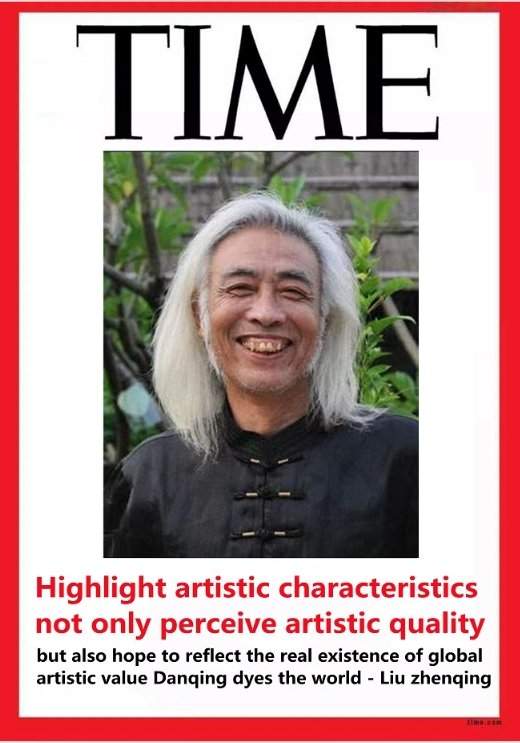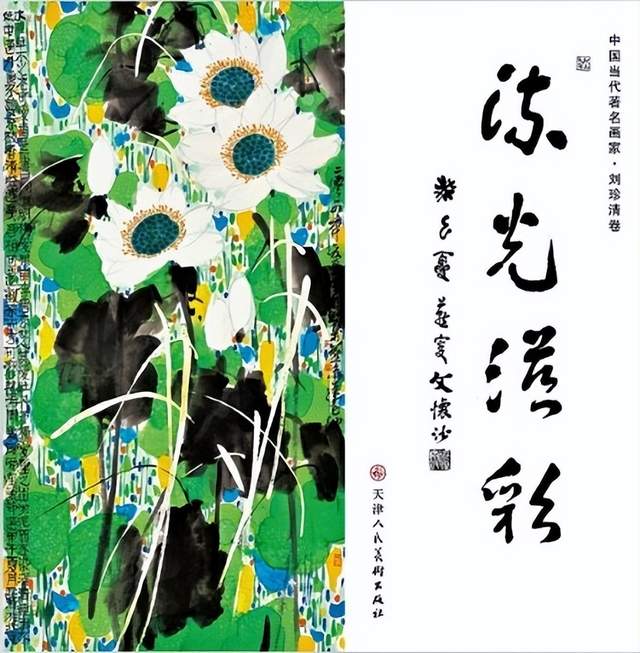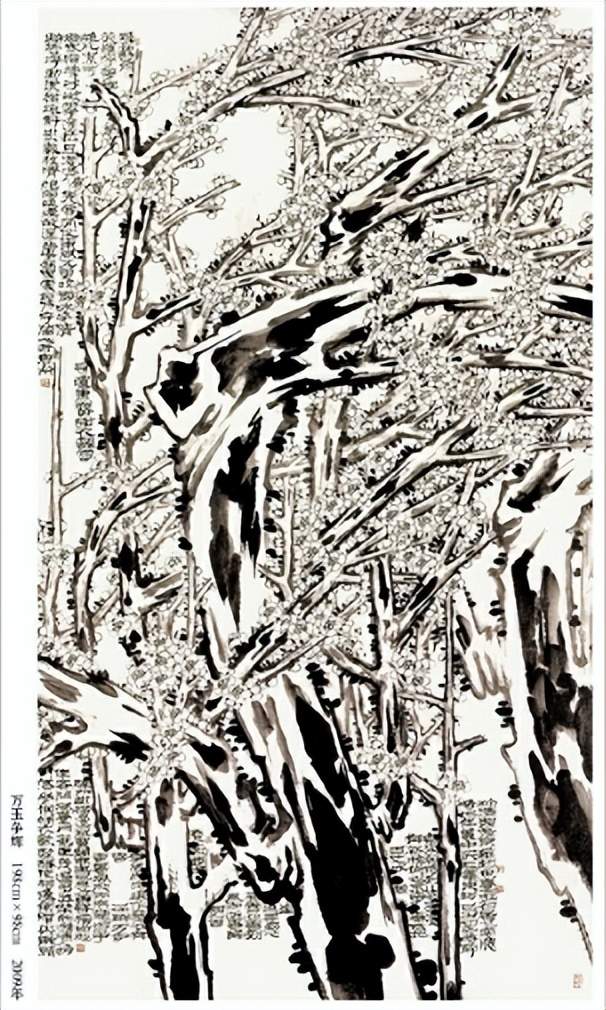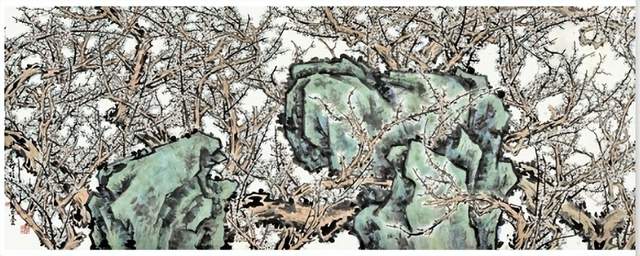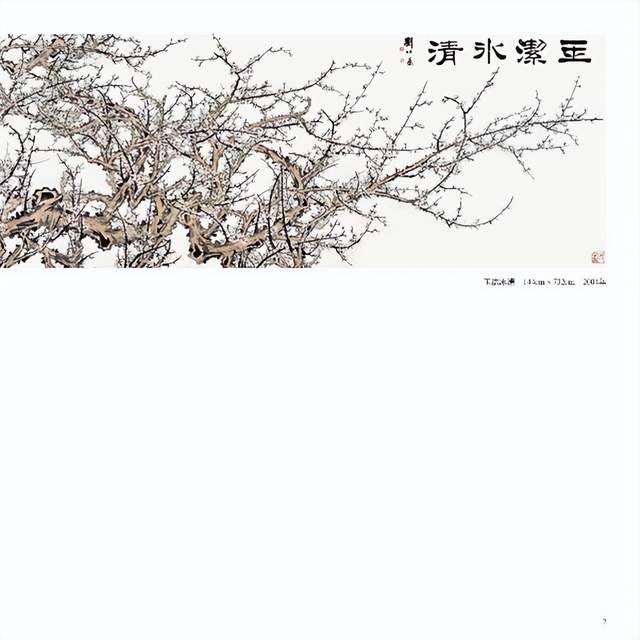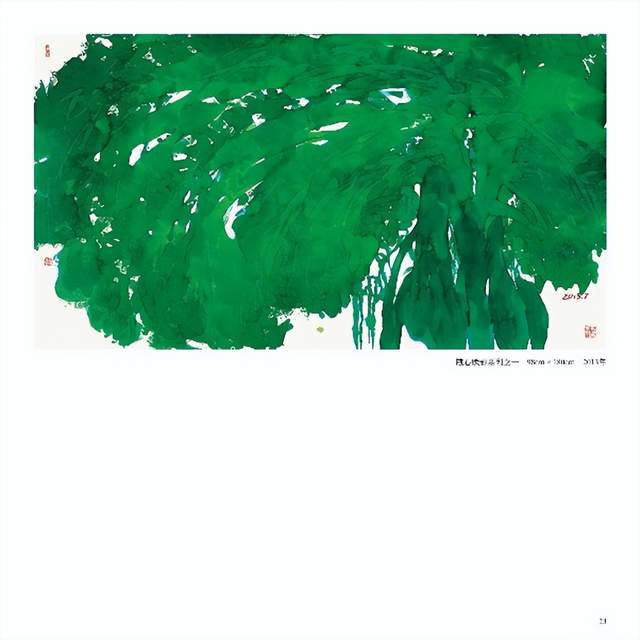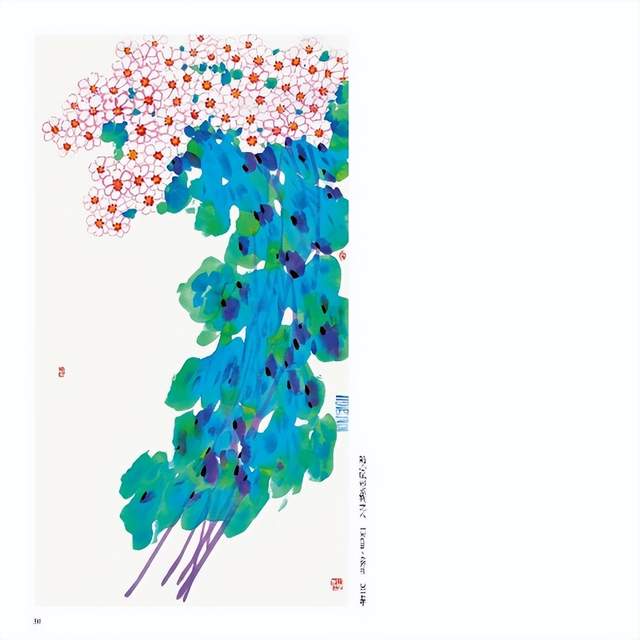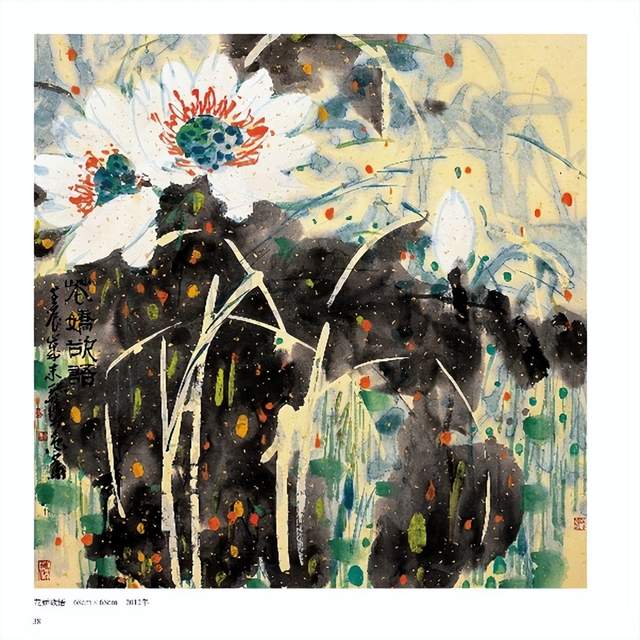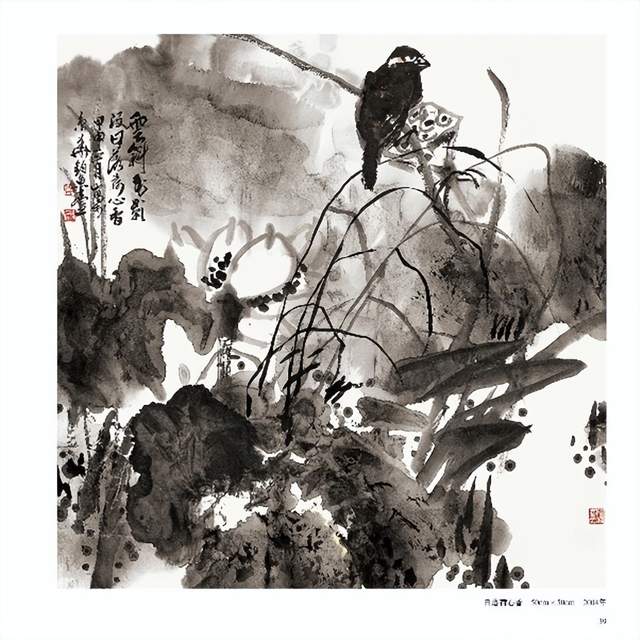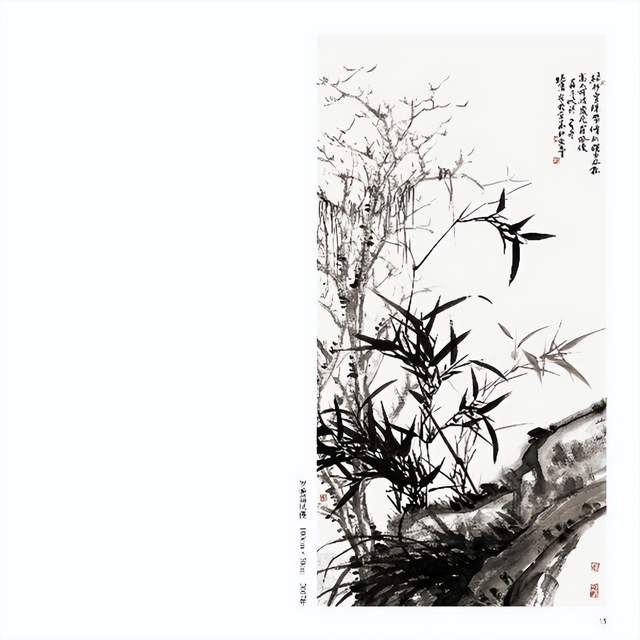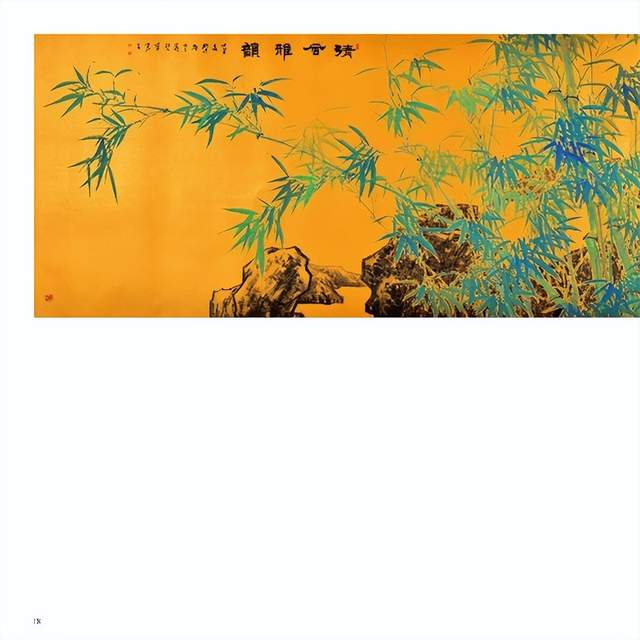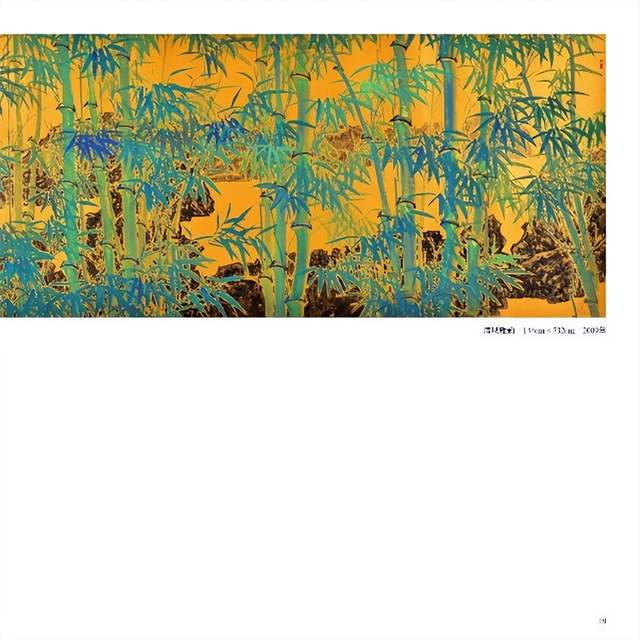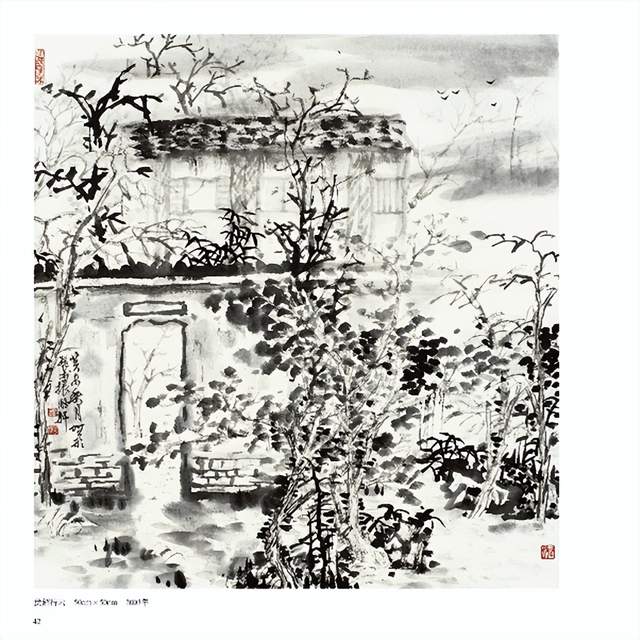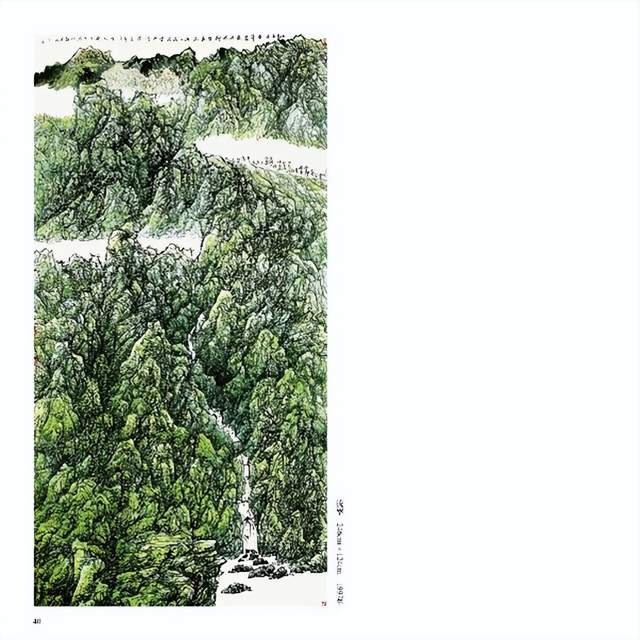刘珍清:
湖北京山人。先后毕业于北京大学书法艺术研究班,中国美术学院国画系、中国画研究院首届高级研究班姜宝林工作室,现为中国画院画家,国家一级美术师,中国国学院客座教授。
作品多次参加全国美展并获大奖,其中《残荷》(1991)入选香港中国艺术大展获银奖,《香中别有韵》(1999)年在由《人民日报》、《解放军报》联合举办的“七彩云南杯”全国书画大赛中获金奖,并发表于《人民日报》1999年11月12日及《美术世界》副刊上,《苍然》(2000)入选由文化部,中国文联,《人民画报》社联合举办的“世界华人艺术大展”获银奖,《玉洁冰清》(2001)入选中国美协举办的“庆祝建党80周年全国美展”,《溪寻方壑》(2002)入选纪念毛泽东“讲话”发表60周年全国美展获优秀奖。
作品在《人民日报》、《中国文化报》、《美术向导》、《中国书画报》、《美术报》、《国画家》等报刊上发表作品300余件,曾在日本及中国香港、中国台湾、中国美术馆、中国画研究院美术馆、军事博物馆、全国政协礼堂、济南美术馆、兰州美术馆、浙江美术学院美术馆、杭州画院、广州、深圳、上海等地举办个展和联展,部分作品被人民大会堂、天安门城楼、国内美术馆、画院、纪念馆、博物馆和国际友人收藏。个人艺术传略被《中国当代书画家辞典》等30余部典籍收录,2013年首届“湖北艺术大典”荣获年度功勋艺术家称号。
出版个人专辑《中国画名家作品集——刘珍清中国画选》(北京工艺美术出版社),《流光溢彩——中国当代著名画家•刘珍清卷》(天津人民美术出版社),《光明网》艺术人生,最美名家——刘珍清专访,武汉电视台录制专题片《湖北功勋艺术家刘正清》,香港《文汇报》2014年4月4日A特刊专版刊发《荆楚丹青之刘珍清》。
Liu Zhenqing:
Jingshan, Hubei Province. He graduated from the Calligraphy Art Research Class of Peking University, the Chinese Painting Department of China Academy of Art and Jiang Baolin Studio of the First Advanced Research Class of Chinese Painting Research Institute. He is now a painter of China Painting Academy, a national first-class artist and a visiting professor of China National University.
His works have participated in many national art exhibitions and won awards. Among them, "Residual Lotus" (1991) was selected into the Hong Kong Chinese Art Exhibition and won the Silver Award. "There is a rhyme in fragrance" (1999) won the gold medal in the "Colorful Yunnan Cup" National Painting and Calligraphy Competition jointly organized by People's Daily and Liberation Army Daily. And published in People's Daily on November 12, 1999 and the supplement of Art World. "Cangran" (2000) was selected into the "World Chinese Art Exhibition" jointly organized by the Ministry of Culture, China Federation of Literary and Art Circles and People's Pictorial, and won the Silver Award; "Yujie Bingqing" (2001) was selected into the "National Art Exhibition Celebrating the 80th Anniversary of the Founding of the Party" organized by China Artists Association; "Xi Xun Fang He" (2002) was selected into the National Art Exhibition Commemorating the 60th Anniversary of Mao Zedong's Speech
His works have published more than 300 works in People's Daily, Chinese Culture Newspaper, Art Guide, Chinese Painting and Calligraphy Newspaper, Art Newspaper, Chinese Painter and other newspapers. He has held solo exhibitions and joint exhibitions in Japan, Hong Kong, Taiwan, China Art Museum, Chinese Painting Research Institute Art Museum, Military Museum, National Committee of the Chinese People's Political Consultative Conference Auditorium, Jinan Art Museum, Lanzhou Art Museum, Zhejiang Academy of Fine Arts Art Museum, Hangzhou Painting Academy, Guangzhou, Shenzhen and Shanghai. Some works are collected by the Great Hall of the People, Tiananmen Gate Tower, domestic art galleries, painting academies, memorial halls, museums and international friends. Personal art biography has been included in more than 30 classics such as Dictionary of Contemporary Chinese Painters and Painters. In 2013, the first Hubei Art Grand Ceremony won the title of Meritorious Artist of the Year.
Published his solo album Collection of Famous Chinese Paintings-Selected Chinese Paintings by Liu Zhenqing (Beijing Arts and Crafts Publishing House), "Colorful-Liu Zhenqing Volume of Famous Contemporary Chinese Painter" (Tianjin People's Fine Arts Publishing House), "Guangming. com" artistic life, the most beautiful famous artist-an exclusive interview with Liu Zhenqing, Wuhan TV Station recorded the feature film "Hubei Meritorious Artist Liu Zhengqing", and Hong Kong Wen Wei Po published "Liu Zhenqing of Jingchu Danqing" in special issue A on April 4, 2014.
一个异类的滴墨成伤
——为刘珍清君新作而作
文 / 谢海
中国绘画历史上,宗教绘画一直有着强大的传统,后来从状物到借物抒情慢慢形成了气候,再到画家把画画当成玩,我们发现,绘画变得越来越艺术的同时,事情变得越来越复杂了。先复杂的是身份,画工、画家、文人——不断在变幻,画工和画家一般都有前缀,前者加两个字合起来扯上关系的,称谓一般都特别冗长,通常的写法是这样的,某某某,官职什么什么,工书画,善什么(科)。尤精什么(项)。他们不愿意说自己是画家或书家,因为在他们看来,所谓文人,琴棋书画是份内的事,不值得炫耀。由此,得出的结论是,画工是为别人做事,画家是为领导做事,文人是在给自己做事。
按照所有美术史书里所写,文人还又画画写字的前提都是士大夫,否则,很难再青史上留下名声。当然,也有例外,例外就是绝少部分,那些绝少部分包括终生不仕且在美术史上享有薄名的林和靖。按照套路,林和靖的介绍是这样的:善绘事,惜画从不传,工行草,书法瘦挺劲键,笔意类欧阳询、李建中而清劲处尤妙。林和靖的书画名气不大,可是,他的“以梅为妻,以鹤为子”的“梅妻鹤子”之典却流传甚广,他在《山园小梅》中所写的“疏影横斜水清浅,暗香浮动月黄昏”更是咏梅的绝唱。
中国传统绘画原本是“成教化、助人伦”的一种手段,后来,托物抒情演变成了“聊写心中逸气”,再后来,也就是当下,加上脱离物象的抽象水墨,三个完全不同的价值取向形成了中国传统绘画在当代文化语境齐头并进的格局。
我的朋友刘珍清显然是第二种类型。他用饱含真情的画笔,通过对物的吟咏,抒发诗人般的艺术感情。
套一个旧式的范本,介绍刘珍清,我要这样说:刘珍清,湖北京山人,客居北京,善绘事,喜作梅、竹、山水亦有古意,近年来尝试用色彩改良中国传统花鸟画而新意别出。
珍清是与我相交20年的老友,我很自信这几十个字足以勾勒他的大致情况。但是,作为老友欲出画册、办展在即,这些许文字实在过于薄情寡义。
不过,我一直想不好怎么样送珍清一篇好文章,即便是看着他送来出版社已经打印出来的画册清样。
画册清样里包括他所擅长梅、竹,和这些年他探索型的花鸟作品。他只说让我看看,让我给他的新画册出出点子。其实,他说的很婉转,因为分明画册清样的最前面留了两个百页,我知道那是我的“活”。
刘珍清是一个肯帮助人又不愿求人的人,他有真性情、真肝胆、重道义。每次我去北京,不管公事私事,只要一个电话,他一定是全程陪同。如果,哪一次没给他打电话,事后他一定要抱怨我很长时间。问题是,珍清不是我一个朋友,他转益多师,多次壮游大江南北,交友广泛,我一直在想,他把时间给了朋友,他哪有时间画画呢!每次,我说你不要陪了,留点时间画画吧!他都会憨憨地笑,然后诡异地说,我会变魔术,我会变魔术。
我知道珍清都是用“挤”出来的时间画画的,他除了画画也没有其他什么嗜好,所以,时间对于他,只有两个用途——画画和交友——这让我又想起了林和靖,或许这也是他偏爱画梅、画竹德一个重要理由。
在文学界,咏物诗与情诗一样,数量很多,是古典诗歌中的一个大类。在美术界,四君子也是传统文人画所占比重较大的一个部分。傲雪耐寒的梅花,清风高节的竹,寄托中国传统文人在逆境中坚贞不移的品格,这在古典诗词、古代绘画中屡见不鲜,但是把疏疏落落的梅枝,纵横交错,映在清浅明澈的池塘中,有姿态、有动静、有味道、有气氛的描写,林和靖是一个,既能雅致又有韵趣、既爱且敬的描绘,王冕是一个,这样的人着实不多。
王冕屡试不第,后来把自己文章付之一炬,只能广栽梅竹,弹琴赋诗,饮酒长啸。这和刘珍清君又有一比。珍清在荆州、在杭州后来定居的北京,参加了很多高研班、名家班的学习,事实上,珍清在这种学习之前已经很会画了,负笈异地的学习对于他只不过是文人唱和的一种延伸。
古今文人墨客,嗜竹咏竹者众多。刘珍清亦喜画竹。李白说,绿竹入幽境,青萝拂行衣;杜甫说,绿垂风折笋,红绽雨肥梅;王维说,绿竹含新粉,红莲落故衣……这些文坛大佬写景、写物用词十分讲究。然而到了苏东坡、郑板桥的笔下,清高洒脱、遗世独立的寄托讲究成了文字的同时,还转换成一幅幅精美的画图,苏东坡说,宁可食无肉,不可居无竹。郑板桥说,咬定青山不放松,立根原在破岩中;千磨万击还坚劲,任尔东西南北风。在老百姓的眼里,郑板桥是这个世界最会画竹的人,因为竹的形象在他笔下带有作者本人浓厚的感情色彩。如果用一种更为文学化的说法,则是:诗人亦或画家的郑板桥笔下的竹不仅仅是客观的描写与被描写的关系,而是达到了精神上的无间契合。
郑板桥之后画竹者,刘珍清不是其中的唯一,不是最好的一个,但是,他喜欢画竹,大幅小件通吃,春夏秋冬全能。
我一直说,我们这个时代不需要那么多画家,画家中也不需要那么多记录时事者。在汗牛充栋的史迹中、文献里、史书、史诗是屈指可数的,同样,历史画也是少得可怜的。只是,当代画坛的创作盛况让所有略懂文史的人汗颜,我们反复扪心自问,为什么不接续司马迁、《世说新语》和张岱的文脉,你再怎么探索语言、艺术和创造力的极限可能,都是异类。
还好,好在李白、杜甫、王维,好在徐渭、八大、吴昌硕、齐白石这些“大个”还在顶着,异类并不丢人现眼。
问题是并不是每个异类都有资格成为名满天下的异类的。问题还有,你有没有资格当异类,再者,你有当异类的资格,你有当异类的心境和方法论吗?
刘珍清是这个时代的“异类”,他给自己画画,画自己喜欢的画。他从一开始的创作就回到了艺术的源头:追求韵趣和对世界的偏僻看法,他从古代文人的本为出发,用一个现代文人视角从个人经验出发、发现、想象和改写事物之间的关系和意义,并与读者分享秘密。刘珍清的绘画语言有背景、有来历,他相信笔触是人类经验只丰饶、心灵之深微的最后见证,他用相信寓意和抒情能展现出神采飞扬。更为关键的是,他的独立独行,代表着别样的信念,代表着别样的品格,也代表着别样的人生,具有与中国当下艺术主流不同的思维方向,拓展了中国当代画坛的艺术空间。
写梅画竹几乎是刘珍清绘画的全部,而事实上,特别是这些年,他还思考着传统花鸟画在当代转型为新样式的可能。不过,这种思考尚在框架和构建之中。我看过他的这一类作品,很新,但多少又有一些无厘头。1919年,56岁的齐白石衰年变法,花了十几年的时间,艰难探索,终于“扫除凡格”,“变更”了面貌,登上了大雅之堂。陆俨少晚年画风一变,只是去日无多,输给了时间。很多画家到了五十岁之后,开始有意无意的“衰年变法”,如果说,这是中国画家的一种宿命,那么,显而易见地是,刘珍清的变法是顺势而为的,这和他为人处世的方法如出一辙,他不会因为自己的梅、竹在社会上有一定的影响而放弃自然。不过,刘珍清的变法还刚刚开始,尚无法得到时间的印证,所以,我无法揣测他的未来。但在我看来,只有逆水潜行、迎风破浪,方可彰显艺术家之本色。
在这个意义上,当我们回过头来重新思考刘珍清的艺术,不难也必定得出这样的结论:一个尊重自己内心的艺术家,在无数次的失败和反反复复的精雕细琢之后,一旦一件艺术作品的完成,那么,在这幅作品之中,人生、思考、艺术、自由、爱就有序的排列了,而且这是与人的生存有呼应联系的滴墨成伤。
谨以此文送给珍清君新出的画册。是为序。
谢海(美术评论部主任,水墨画家)
2014年7月29日于杭州西风堂
An alien ink drip injury
--For Liu Zhen Qingjun's new work
Text/Xie Hai
In the history of Chinese painting, religious painting has always had a strong tradition. Later, the climate gradually formed from objects to borrowing objects to express feelings, and then painters regarded painting as fun. We found that while painting became more and more artistic, things became more and more complicated. What is complicated first is identity. Painters, painters and literati are constantly changing. Painters and painters generally have prefixes. The former is related with two words, and the appellation is generally very lengthy. The usual writing method is as follows: XXX, what is the official position, painting and calligraphy, and what is good (subject). What is especially good at (item)? They don't want to say that they are painters or calligraphers, because in their view, the so-called literati, chess, calligraphy and painting are their job and are not worth showing off. From this, the conclusion is that painters do things for others, painters do things for leaders, and literati do things for themselves.
According to all art history books, the premise for literati to draw and write is scholar-officials, otherwise, it is difficult to leave a reputation in history. Of course, there are exceptions, and the exceptions are very few, including Lin Hejing, who has been an official all his life and enjoys a thin name in art history. According to the routine, Lin Hejing's introduction is as follows: he is good at painting, cherishes painting and never passes it on, ICBC grass, calligraphy is thin and vigorous, and his brushwork is like Ou Yangxun and Li Jianzhong, but his vigor is especially wonderful. Lin Hejing's paintings and calligraphy are not well-known, but his code of "Mei Wife and Crane Son", which takes Mei as his wife and crane as his son, has spread widely, and his book "Shadow Horizontal Inclined Water Clear and Shallow, Dark Fragrance Floating on the Moon at Dusk" written in "Xiaomei in Mountain Garden" is Yongmei's swan song.
Chinese traditional painting was originally a means of "educating and helping others". Later, expressing feelings by supporting things evolved into "talking and writing in the heart". Later, that is, at present, with abstract ink painting separated from objects, three completely different value orientations formed a pattern in which Chinese traditional painting went hand in hand in contemporary cultural context.
My friend Liu Zhenqing is obviously the second type. He expressed his artistic feelings like a poet by chanting things with a brush full of true feelings.
Set an old model to introduce Liu Zhenqing. I want to say this: Liu Zhenqing, a native of Jingshan, Hubei Province, lives in Beijing, is good at painting things, likes to make plum and bamboo, and has ancient landscapes. In recent years, he has tried to improve Chinese traditional flower-and-bird paintings with colors.
Zhenqing is an old friend who has been with me for 20 years, and I am confident that these dozens of words are enough to outline his general situation. However, as an old friend, he wants to publish a picture album and hold an exhibition soon, so these Xu words are too fickle and unjust.
However, I have been thinking hard about how to send Zhenqing a good article, even watching him send a clean sample of the album printed by the publishing house.
The clear sample of the album includes plum and bamboo, which he is good at, and his exploratory flower and bird works in recent years. He just said let me have a look and let me come up with ideas for his new album. In fact, he said very tactfully, because it is clear that there are two hundred pages left at the front of the clear album, and I know that it is my "living".
Liu Zhenqing is a person who is willing to help others but unwilling to ask for help. He has true temperament, courage and morality. Every time I go to Beijing, regardless of business or private affairs, as long as I make a phone call, he must accompany me all the way. If you don't call him once, he must complain about me for a long time afterwards. The problem is that Zhenqing is not a friend of mine. He has turned to benefit from many teachers, traveled across the country for many times, and made a wide range of friends. I have been thinking that he gave time to his friends, so how can he have time to draw? Every time, I say you don't want to accompany, leave some time to draw! He would laugh foolishly, and then say eerily, I can do magic, I can do magic.
I know that Zhenqing paints with "squeezed" time, and he has no other hobbies except painting. Therefore, time has only two uses for him-painting and making friends-which reminds me of Lin Hejing again. Perhaps this is also an important reason why he prefers painting plum and bamboo.
In the literary world, poems about things, like love poems, have a large number and are a major category in classical poetry. In the art world, Four Gentlemen is also a part of traditional literati paintings. Aoxue cold-resistant plum blossom, Bamboo with high breeze, Pinning on the unshakable character of Chinese traditional literati in adversity, This is not uncommon in classical poetry and ancient paintings, but the scattered plum branches are criss-crossed and reflected in the pond of clear and shallow Ming Che, with gesture, movement, taste and atmosphere. Lin Hejing is an elegant and interesting description, and Wang Mian is a description of love and respect. There are not many such people.
Wang Mian tried repeatedly, and later burned his articles. He could only plant plum and bamboo, play the piano and write poems, and drink and scream. This is compared with Liu Zhenqing Jun. Zhenqing participated in many advanced research classes and famous classes in Jingzhou and Beijing, where Hangzhou later settled. In fact, Zhenqing was already good at painting before this kind of study, and studying in different places was just an extension of literati singing.
There are many ancient and modern literati who love bamboo and chant bamboo. Liu Zhenqing also likes painting bamboo. Li Bai said that green bamboo enters the secluded environment, and green Luo blows clothes; Du Fu said that the green wind folds bamboo shoots, and the red rain fats plum; Wang Wei said that green bamboo contains new powder, while red lotus falls into old clothes... These literary leaders are very particular about the words used in writing scenery and things. However, in Su Dongpo's and Zheng Banqiao's works, the sustenance of lofty, free and easy, and independence became words, and at the same time, it was transformed into exquisite pictures. Su Dongpo said that he would rather eat without meat than live without bamboo. Zheng Banqiao said, insisting that Qingshan does not relax, and the roots are in the broken rocks; Hard work and hard work, let the east, west, north and south wind. In the eyes of ordinary people, Zheng Banqiao is the best painter of bamboo in the world, because the image of bamboo in his works has the author's own strong emotional color. If you use a more literary The saying of transformation is that the bamboo written by Zheng Banqiao, a poet or painter, is not only an objective relationship between description and being described, but also a spiritual harmony.
Liu Zhenqing is not the only one who paints bamboo after Zheng Banqiao, not the best one. However, he likes to paint bamboo, and he can eat large and small pieces, and he is omnipotent in spring, summer, autumn and winter.
I have always said that we don't need so many painters in our time, and painters don't need so many people who record current affairs. Among the numerous historical sites and documents, there are only a handful of historical books and epics, and similarly, historical paintings are pitifully few. However, the grand occasion of contemporary painting makes all those who know a little about literature and history feel ashamed. We repeatedly ask ourselves why we don't continue the context of Sima Qian, Shi Shuo Xin Yu and Zhang Dai. No matter how you explore the limits of language, art and creativity, they are all different.
Fortunately, Li Bai, Du Fu, Wang Wei, Xu Wei, the Eighth National Congress, Wu Changshuo, Qi Baishi, the "big ones", are still at the top, and the aliens are not shameful.
The problem is that not every alien is qualified to be a world-famous alien. The question is, are you qualified to be an alien? Furthermore, do you have the qualification to be an alien? Do you have the mood and methodology to be an alien?
Liu Zhenqing is an "alien" in this era. He paints for himself and his favorite paintings. From the very beginning, he returned to the source of art: pursuing charm and remote views on the world. Starting from the original purpose of ancient literati and personal experience from a modern literati perspective, he discovered, imagined and rewrote the relationship and significance between things, and shared secrets with readers. Liu Zhenqing's painting language has background and origin. He believes that brushwork is the last witness of human experience and deep soul. He believes that moral and lyricism can show his spirits. More importantly, his independence represents a different belief, a different character and a different life. He has a different thinking direction from the current mainstream of Chinese art and expands the artistic space of contemporary Chinese painting circles.
Writing plum and painting bamboo is almost the whole of Liu Zhenqing's paintings. In fact, especially in recent years, he also thought about the possibility of transforming traditional flower-and-bird paintings into new styles in contemporary times. However, this kind of thinking is still in the process of framework and construction. I have seen his works of this kind, which are very new, but somewhat nonsense. In 1919, 56-year-old Qi Baishi spent more than ten years and hard exploration, and finally "swept away Vange", "changed" his face and stepped onto the elegant hall. Lu Yanshao's painting style changed in his later years, but there was not much to go and he lost to time. After the age of 50, many painters began to "reform in the declining years" intentionally or unintentionally. If this is a fate of Chinese painters, it is obvious that Liu Zhenqing's reform is based on the trend, which is exactly the same as his way of dealing with people. He will not give up nature because his plum and bamboo have certain influence in society. However, Liu Zhenqing's political reform has just begun, and it can't be confirmed by time, so I can't speculate on his future. But in my opinion, only by sneaking against the current and breaking the wind and waves can the artist's true colors be revealed.
In this sense, When we go back and rethink Liu Zhenqing's art, It is not difficult and certain to draw such a conclusion: an artist who respects his heart, after numerous failures and repeated meticulous carving, once a work of art is completed, then in this work, life, thinking, art, freedom and love are arranged in an orderly manner, and this is a drop of ink that echoes human survival.
I would like to send this article to Zhen Qingjun's new album. Is the order.
Xie Hai (Director of Art Review Department, Ink Painter)
July 29, 2014 at Xifeng Hall, Hangzhou

